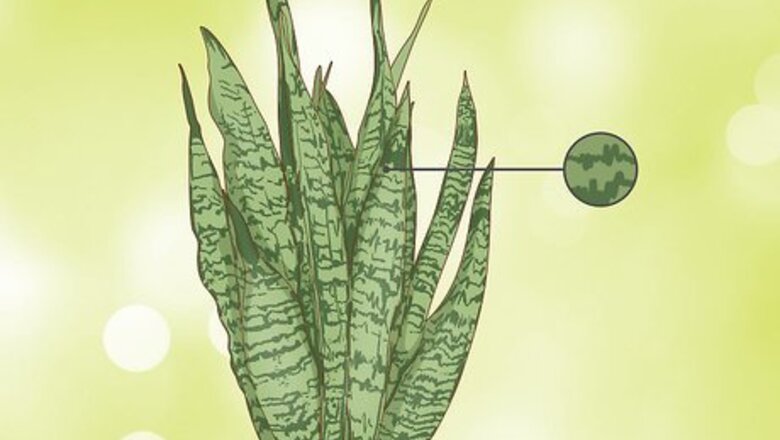
views
Re-Potting Your Plant
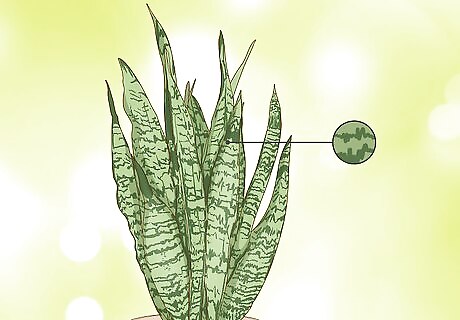
Look for dark green leaves to make sure your sansevieria is healthy. Dark leaves on a snake plant indicate that it is healthy and well-nourished. Leaves that have a yellowish tinge on the outer edge of the leaves or leaves that are pale and floppy could indicate that the plant is dying. Don’t re-pot your plant until it’s healthy so it can adjust to its new home and survive the transfer. A pale sansevieria doesn’t necessarily mean that the plant will die. It may just need some water and care and you can bring it back to life!
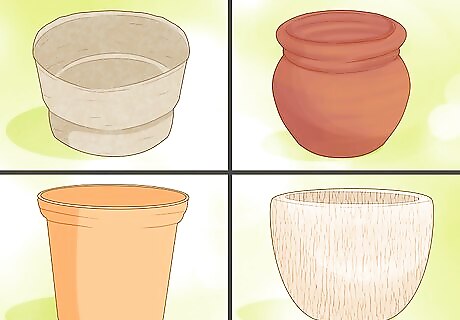
Get a pot made out of a porous material. Sansevieria are very susceptible to rotting out, especially if they sit in water for too long. Choose a pot that has good drainage, like a terra cotta pot or a pot made with another porous material so your snake plant isn’t at risk of rotting. Porous materials include terra cotta, clay, timber, paper pulp, and other natural materials that allow moisture to move through them.Tip: If you plan to keep your snake plant outside, choose a darker color pot to attract more heat, especially if you live in an area that freezes. If you want to use a decorative pot that doesn't have drainage holes, place your plant inside a plastic grow pot, then set the grow pot inside of the decorative pot.
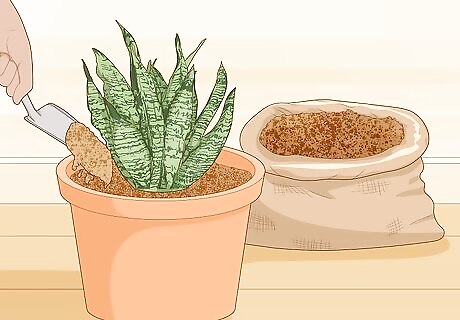
Choose a potting mix that allows for good drainage. Snake plants don’t require too much water, and their roots can actually be damaged if they’re allowed to soak in soil that is full of moisture. To allow for good drainage and a healthy root system, choose a free-draining soil mix or even a soilless potting mixture. Place your sansevieria into the potting mixture and cover it with enough to hold it secure in the pot. Many potting mixes that you can purchase from gardening stores are designed to help control moisture and improve drainage. Check the packaging for information on the potting mix. Use a soilless potting medium like vermiculite, peat moss, or perlite.
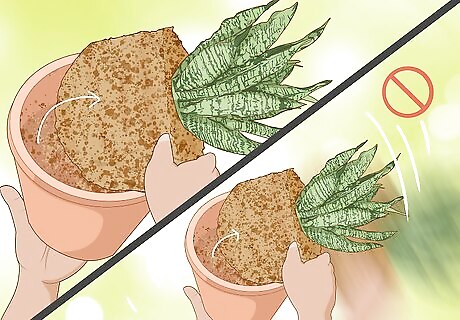
Grasp the sansevieria at the base of the leaves and pull it from the pot it came in. When you’re ready to re-pot your snake plant, take a firm hold of the base of the leaves, where they connect to the soil. Gently slide the plant out of its pot. Don’t shake any dirt loose from the roots. Be careful not to yank or jerk the plant or you could separate the leaves from the roots and kill the plant.
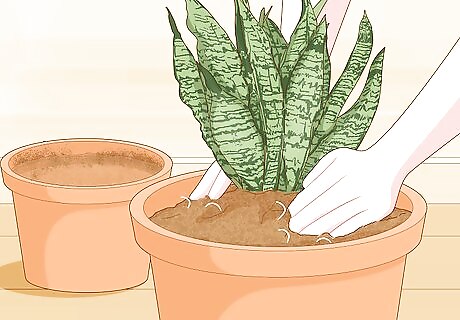
Place the snake plant into its new pot and add soil to cover the roots. Move the plant to its new pot and add enough soil or soilless mixture to support the plant and keep it upright. Add more soil mixture if the sansevieria leans to one side or is unstable in the pot. Hold the snake plant in an upright position while you add soil to the pot. Pack the soil down by patting it with your hand to add support to the plant.
Creating the Right Environment
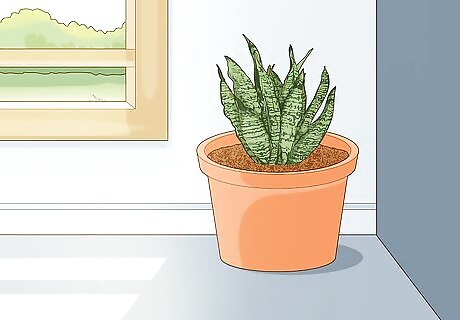
Place the sansevieria in indirect sunlight. Snake plants are hardy, tough plants that can survive in full sunlight, as well as very low light. But they really thrive in indirect sunlight, which is why they are such great houseplants. Indirect sunlight can be near an eastern facing window or in the center or corner of a room that isn’t directly exposed to sunlight coming in through a window. Snake plants prefer natural light, so avoid putting them in a room without any windows.
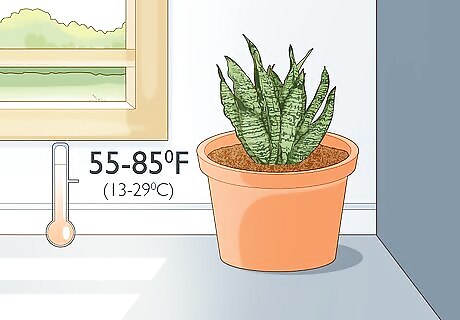
Keep the temperature between 55–85 °F (13–29 °C). Sansevieria prefer warmer temperatures, but anything above 85 °F (29 °C) is dangerous for the plant and will cause it to start to wilt. Snake plants are also susceptible to cold temperatures. Anything below 50 °F (10 °C) can kill the roots of the plant. Temperature fluctuations do not generally affect snake plants as long as the temperature stays within their preferred range.Tip: Frost is especially harmful to sansevieria. If you plan to keep your snake plant outside, be sure to bring it in before a hard freeze!
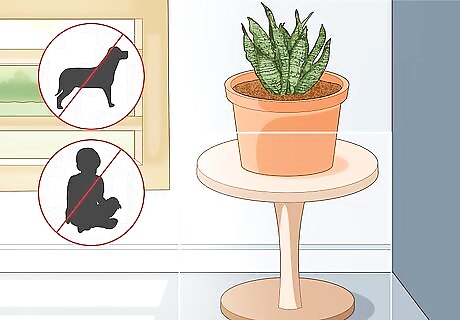
Do not place your sansevieria somewhere pets or babies can reach it. Snake plants have a low level of toxicity, but they can cause pain, nausea, vomiting, and diarrhea if they’re ingested. Pets and small babies are at particular risk of accidentally eating some of the leaves. Be sure to place your snake plant somewhere out of reach to them. A floating shelf or stool can elevate your plant and keep it out of reach.
Maintaining Your Sansevieria
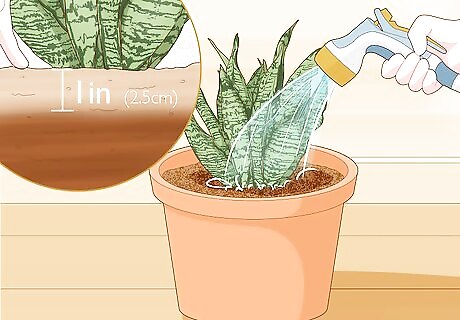
Water your sansevieria when the top 1 inch (2.5 cm) of soil is dry. Snake plants do not need lots of water, which is one of the reasons why they’re so easy to care for. In fact, you may be more likely to overwater the plant and put the roots at risk of rotting. To be safe, only water your snake plant when the top layer of the soil is completely dry. Check the soil by sticking your finger into it to see if there is moisture. Add enough water to saturate the soil, but not so much that there’s standing water in the pot. The excess water should drain out of the pot.Tip: If you’re using a soilless potting mixture, water your sansevieria once a week.
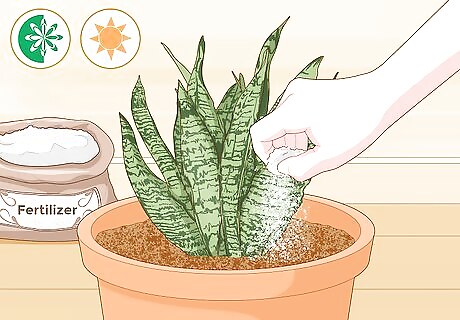
Add fertilizer every few weeks in the spring and summer. Snake plants don’t need much fertilizer, but they will grow more if you fertilize them during their growing season in the spring and summer. Use a basic fertilizer for houseplants and only add it every few weeks or every other watering. Check the packaging on the fertilizer that you choose to follow the correct dosage and method. Never give your plants fertilizer while they're dormant, which is usually during the winter months.
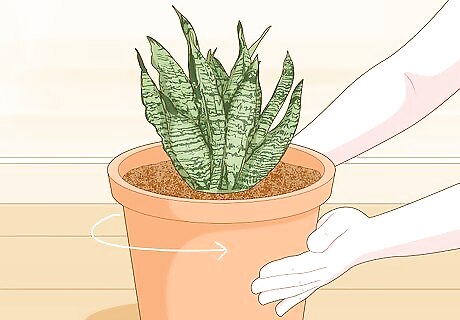
Turn the pot weekly so the leaves get even light exposure. To ensure that your snake plant grows evenly and all of the leaves are receiving adequate exposure to sunlight, rotate the pot about a quarter turn. This will also keep your plant growing vertically, rather than leaning in one direction. An easy way to remember is to turn the pot whenever you water your sansevieria.
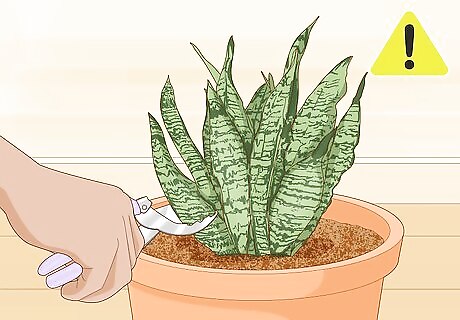
Avoid trimming sansevieria. Unlike other houseplants, pruning snake plants does not stimulate growth. They are such slow growers that injuring them by trimming or pruning will actually cause them to slow their growth as they heal. If you want to keep your snake plant a specific height and size, trim it sparingly to keep it healthy. Repeated pruning and trimming will damage them and could kill them.
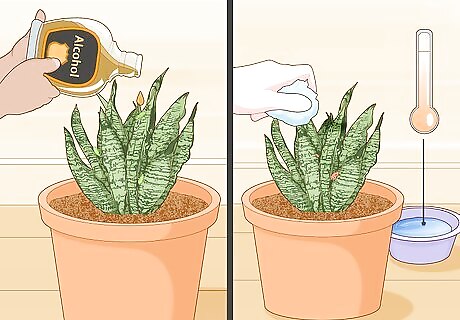
Keep an eye out for pests on the sansevieria. Mealybugs and spider mites are the main pests that like to feed and make their homes on snake plants. Whenever you water your plant, inspect the leaves for any insects. You can get rid of mealybugs by dropping a small drop of alcohol onto them. Wash the leaves with warm water and a cloth to remove spider mites. Pests may be a sign that your plant is unwell. Restoring the plant's health will usually prevent bugs from preying on it.












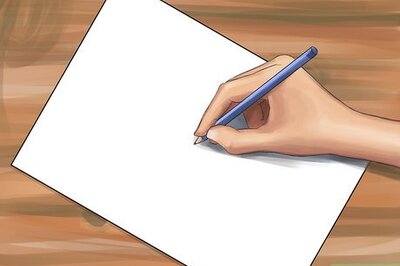




Comments
0 comment